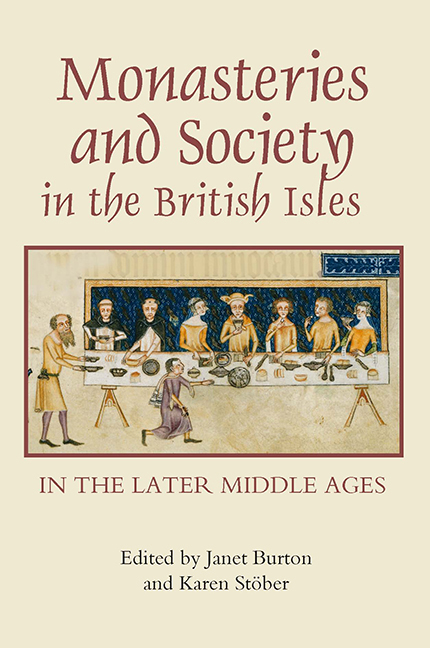Book contents
- Frontmatter
- Contents
- List of illustrations
- Acknowledgements
- List of contributors
- Abbreviations
- Introduction
- The Meeting of the Worlds
- 1 The social networks of late medieval Welsh monasteries
- 2 Cistercian hospitality in the later Middle Ages
- 3 Cistercians and border conflicts: Some comparisons between the experiences of Scotland and Pomerania
- 4 ‘Not a thing for a stranger to enter upon’: The selection of monastic superiors in late medieval and Tudor England
- Religious Houses and their Patrons and Benefactors
- Female Communities: Nuns, Abbesses and Prioresses
- Monasteries and Education
- Monasteries and Urban Space
- Religious Houses in the Regions
- Index of Religious Houses mentioned in the text
- Index
- Miscellaneous Endmatter
1 - The social networks of late medieval Welsh monasteries
from The Meeting of the Worlds
Published online by Cambridge University Press: 24 October 2017
- Frontmatter
- Contents
- List of illustrations
- Acknowledgements
- List of contributors
- Abbreviations
- Introduction
- The Meeting of the Worlds
- 1 The social networks of late medieval Welsh monasteries
- 2 Cistercian hospitality in the later Middle Ages
- 3 Cistercians and border conflicts: Some comparisons between the experiences of Scotland and Pomerania
- 4 ‘Not a thing for a stranger to enter upon’: The selection of monastic superiors in late medieval and Tudor England
- Religious Houses and their Patrons and Benefactors
- Female Communities: Nuns, Abbesses and Prioresses
- Monasteries and Education
- Monasteries and Urban Space
- Religious Houses in the Regions
- Index of Religious Houses mentioned in the text
- Index
- Miscellaneous Endmatter
Summary
They were never numerous: little more than forty houses of monks, canons and nuns ever flourished in late medieval Wales. Yet the religious houses of the Principality were so inextricably linked to the society in which they operated that they can scarcely be separated from it at all. Laymen and laywomen, after all, were responsible for the foundation of Wales's abbeys and priories and contributed to their upkeep, as well as maintaining a range of other types of contact with their abbots and priors, as varied as trading connections and religious services.
The last quarter of the eleventh century saw profound changes in Welsh monasticism, when a number of small Benedictine cells were established by Norman settlers on their newly acquired Welsh lands, and the establishment of a religious foothold to some extent mirrored the Norman advancement into Wales. The Benedictines were closely followed by most of the other main religious orders, although not all of them were equally successful. The Cluniacs, present on Welsh soil from the 1120s, established only two marginal cells here, one in Malpas (Monmouthshire), the other in St Clears (Carmarthenshire), and only one single house of Premonstratensian canons ever flourished. The rather moderate achievement of these religious groups stands in sharp contrast to what can justifiably be described as medieval Wales's monastic success story, the Cistercian monks. Although little more than a dozen in number, plus two nunneries, the Cistercian houses came to dominate the Welsh monastic stage like no other religious order. Unlike in England, they were both more numerous and more influential than the regular canons, who enjoyed such popularity east of Offa's Dyke. Nonetheless, between the first decade of the twelfth century and the middle of the thirteenth, the reforming spirit of the Augustinian canons was instrumental in the transformation of the characteristic Welsh clas system into priories of their order, in time taking over the remaining existing native religious communities. Continental monasticism thus gradually but effectively replaced the older Welsh monasteries, and by the mid-twelfth century new monastic foundations were in existence both in Pura Wallia and in the Anglo-Norman dominated parts of Wales. By the later Middle Ages, the abbeys and priories of Wales had become established, if frequently small, institutions, which formed part of a society with which they interacted on many levels.
- Type
- Chapter
- Information
- Publisher: Boydell & BrewerPrint publication year: 2008



